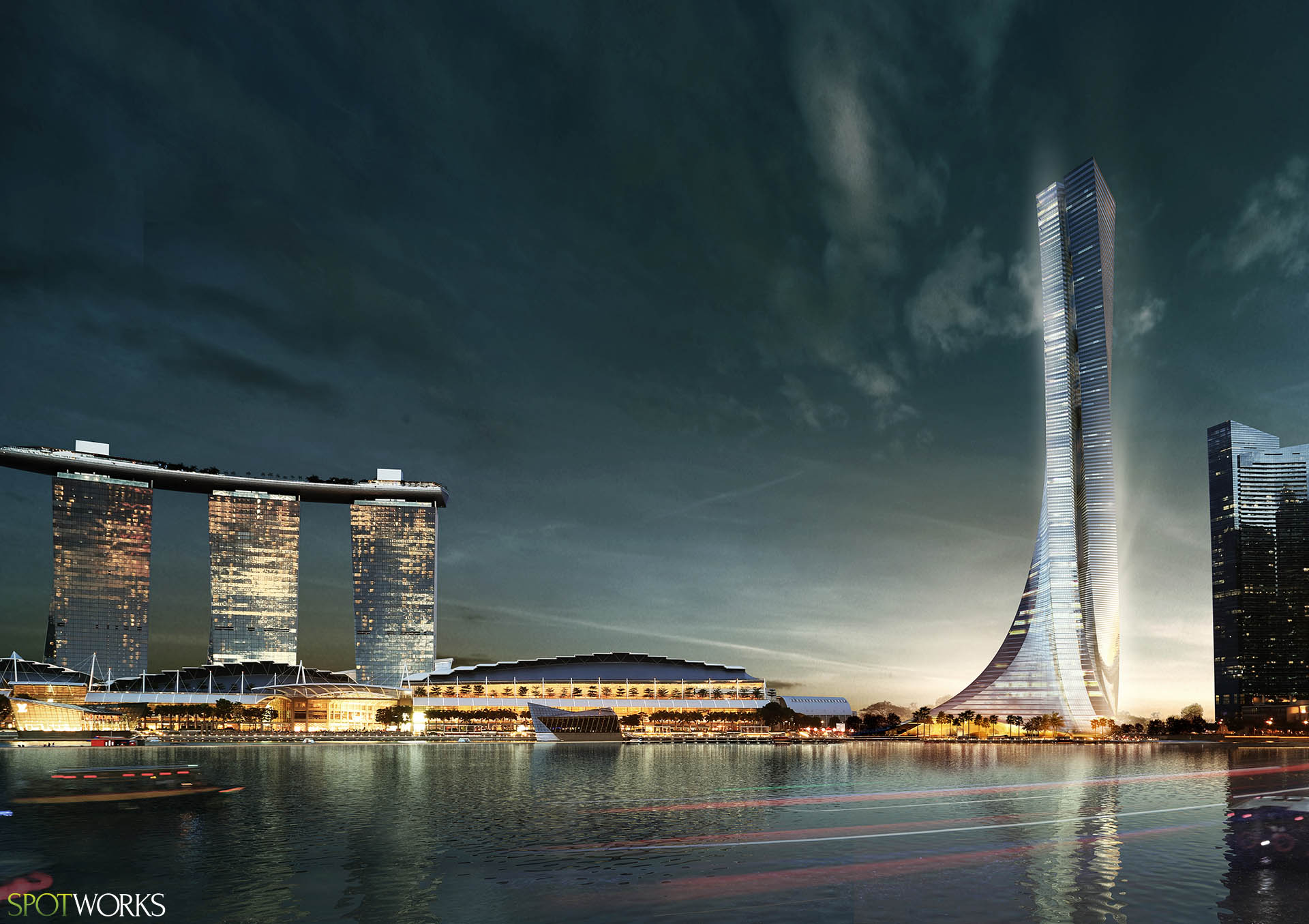What is 3D Rendering?
3D rendering is the process of converting and translating ideas into a 3D model, and eventually to a 2D image. In the old days when technology was not as common as current times, visualisation works were usually done by drawings on huge blueprint papers or by modelling out via physical materials like cardboard.
The key factor for the use of 3D rendering is to visualise a certain product/idea to the most realistic way possible. In the past when technology has yet to exist, ideas can only be conveyed through manual drawings that look two dimensional most of the time. Even if an artist is great at three dimensional drawings, it still lacks realism due to the lack of accurate real world material representation. However, with the help of advance technology and software these days, it is now possible to come up with photorealistic renderings and drawings of a certain idea.
With the above said, it also takes skills and hard work to get a photorealistic render done. Many artists work tirelessly and spend hours creating realistic and stunning visuals even with the help of the latest software and tools. A photo realistic rendering will take a significant amount of time to get all the details down accurately. With a good photorealistic rendering, it will help in many areas like product development, presentations and marketing. The possibilities are endless with 3D rendering.
3D Rendering
To help better understand how 3D rendering is done, we have broken down the process into 3 parts to explain on the process to achieve a visualised image:
1. Modelling and Texturing
Modelling will be the very first step to kick-start the 3D rendering process. The level of detail of a model will determine a rendering’s value. Details will make an image look photorealistic and perfect. Hence, it is important to invest time in modelling to ensure that each detail is accurate.
Another factor in contributing to a good rendering will be the textures of a model. There are cases where artists spend a lot of time modelling, but still fail to deliver a good 3D perspective. The key reason is that the application of the material is not suitable. A suitable high res image that matches the scene/product will make your rendering look realistic. From a material library that contains thousands of textures and images, it is important to spend time in picking up the right textures for your model and what you would like to showcase in the rendering.
2. Setting and Rendering
File preparation and settings are also key to making sure a render will not only turn out good, but allows the artist to work efficiently as well. It is common to have changes along the rendering process, hence a neatly prepared 3D file with the necessary layers will help changes to be done more efficiently with less trouble and additional time involved. Light settings for renders also play a big role in making the entire view stand out and look good. Lighting and shadows help to give depth to a view, which makes a render look more convincing.
An experienced artist will know that the settings for each project are different. As all required perspective and modelling details for each project is unique, the lighting settings and file arrangement has to be changed accordingly as well. However, an experienced artist will be able to work out the settings almost immediately and accurately after working on a myriad of projects. After making sure all materials, textures, lighting and perspective are set to the ideal state, it will be ready to render. The longer the rendering time spent, the more detailed the render can go and hence result in a better quality. It is common practise that artists usually let the render continue to run overnight after work hours.
3. Post-production
Once the high res rendering is completed, the post production works will come into play. As the raw render by 3D software may not always turn out perfectly in terms of certain colours and details, touching up of the rendering will be required. Some of the key areas that will need re-working on post production in place, you can refine your perspective to make it look even better.


How to Choose the Right Software for Rendering?
There are many 3D software in the market now, and it is important to select the right software for the work you require. Before purchasing a software, it is important to do some background research on the functions and available plug in that comes together with the software.
For example, rendering a product vs rendering a fantasy character character can be vastly different and require different tools. Hence, purchasing a proper software can help you greatly in your designing career and management work.
3 Tips in Mind Before you Buy
First of all, look out for the sources that are providing you with the software. Compare the products available and the software’s rendering quality online before making any decision for yourself. It is common that every rendering software in the market comes with a free trial, so do grant the opportunity to test them out to better understand which software fits your needs better.
Secondly, check for what are the available plugins that the software supports. Some of the common plugins for 3D rendering are forest pack, floor generator, augment, vray, corona etc. Some of the plugins will only support certain 3D rendering software, so it will be important to know exactly what are the plugins and functions you need before purchasing the software. Remember, to create a good rendering it does not solely depend on the skills of the artist, but also the right tools to achieve the specific details that you need.
Lastly, you will need the compare all the rates for the software that you need. It is usually the safest to purchase all software from the official website, as it will be easier to recover any lost data or contact their IT support should there be any issues with the software along the way. Alternatively, if you are purchasing the software from any 3rd party organisation, do ensure that the price proposed is reasonable, and that the source of the software is reliable.

4 Advantages of Using 3D Rendering
If you have a skilled 3D artist on your team, then he/she will definitely work in your favour to produce outstanding 3D visualisation for your business needs. Otherwise, you can always engage a reliable 3D rendering company to help you out. It will be best to ensure that you obtain your work from a trusted source to ensure that the outcome of the renders will be of the highest quality. There are endless benefits and possibilities you can get out of 3D rendering, and here is how you can go about it:
1. Wide-out Imagination
You may have heard this saying before that imagination is the only limit in your work. However, times have changed and with the help of 3D rendering, you won’t have to worry about your imagined ideas anymore. Imagination will now be the key to your success to stand out from the crowd.
With 3D modelling and rendering to help you visualise and better understand your project and ideas, you can now see three dimensionally in the virtual world to refine your ideas as you go. Ideas now can be realised more easily, what exciting times we live in!
2. Helps you in adaptability
When you are rendering all your designs in the 3D format then you are adapting your sources in the right way. With the management of adaptability and function by your side, make sure you are going for the best source out there in the market. Adaptability is the key to your work performance. If you adopt for the best then you are making a huge change for your workload as well. Also, you are opening a ton of opportunities for your source of work with the changes and nature of adaption.
3. Time Saving
A photorealistic 3D render will help to save your time and eliminate any work pressure you will possibly face. Suppose you have a submission within a short time frame, and do not have enough time to prepare a full presentation. You can always engage 3D rendering help to visualise your ideas quickly. A 3D photorealistic image will also most probably help to explain and speak more about your project as compared to words and 2D sketches or reference images. Worry no more, and trust in the capabilities of 3D rendering.
4. Reducing costs
Other than saving time while refining your work using 3D rendering, it will actually help you to save costs in the long run too. You can now avoid the hassle of having to change prototypes, spend money on materials and man hours to try to build and present your ideas. With a 3D virtual model and rendering, you can easily replace any elements like materials, size and textures on the computer with minimal costs. Once all details are confirmed, you can then go ahead to build out the prototype with a peace of mind.

Let 3D Rendering Represent your business
In this day and age where social media and technological advancements are abound, everyone relies on visual images to make a lasting impression. To ensure that your business stands out to your target audience, 3D rendering will be a good option to help you create your ideal image to gain attention and recognition. With good visuals, your potential clients will be convinced of your ideas and the capabilities of the business. Investing in 3D rendering will definitely be worth it to boost your career.
Uses of 3D rendering In Different Industries
Now that we have covered some of the basics of 3D rendering and the positive uses that comes with it, we will further elaborate on how versatile 3D rendering is, and how it can be used across many different industries.
The main key point of why 3D rendering is such an attractive tool for the many industries, is that is helps to decrease your project time, and gives your intended project a realistic visual which you can never achieve manually. With the help of a powerful software, creatives can manipulate designs by exploring different options, and creating multiple version of a model.
Here are some of the industries that are using 3D rendering heavily, and we’ll further explain why it is so:
- Architecture and Planning
- TV & Films
- Video Games
- Product Prototyping
- Environment Simulations
- AR & VR
- Engineering
- Surgery & Medical Imaging, etc.

1. Architectural and Planning
While 2D drawings are still commonly used to show the blueprint and layouts of a building structure, and still widely used especially in the construction industry, there are many up and coming new 3D software that is modifying the way we present architecture. There are software like Revit to create BIM models where 2D blueprints are combined to form a 3D model.
With the 3D model being built directly from the 2D blueprints, it helps architects to know the feasibility of a design, and how the design will look like aesthetically in three dimensional form. Gone are the days where the architects will have to only visualise the actual three dimensional structure via sketches and physical modelling that may not be 100% accurate. Now you can easily view your project in different angles with a 3D model.
Other than architects using the 3D model, any related parties in the project can also use the 3D model to input their expertise as well. Engineers, planners, construction managers are all starting to work on 3D models for building development where ideas can be shared across seamlessly in a 3D setting. This helps to refine the project with less communication errors and risks involved, and 3D modelling and rendering is definitely playing a huge role in improving the workflow of the Architectual and Planning industry.
2. Virtual Reality
3D modelling and rendering is slowly moving on towards Virtual Reality (VR) as well. VR is gaining attention all around the world, and the purpose of the VR is to transform all things into a realistic 3D environment. With a VR Tour, you will be able to view it via VR gears and be soaked in 360 degrees virtual environment. You will no longer need to see a visualised idea just simply on a rendered photo or object, and you can now even be immersed in a 3D virtual reality environment.
Virtual Reality started out in the gaming industry, but now it’s purposes has increased tremendously. There are many other industries that are starting to use VR tours to sell an experience and idea, and it is definitely a growing trade now.
3. TV & Film
Another industry that relies on 3D rendering and modelling heavily is definitely the TV & Film industry. The TV and Film industry targets to bring their viewers into a whole new world and journey through storytelling. With this target and intention in mind, it is common that most of the elements that are portrayed in the film has to be unreal and animated using CGI. It is human nature that we want to always see new things that we have yet to see before in our real world. Hence, with the help of 3D software – film artists can now create things of fantasy and portray them realistically.
Perhaps one of the famous film example will be Transformer, where almost every scene you see on the screen are the product of rendering. We don’t have robots and UFOs in our real world, but with 3D rendering you can create a virtual world that looks just like the real deal.
3D Rendering is The Future World
With the above said, 3D rendering is now gaining its foothold on many industries and it has proven to be a useful tool to help boosts business and improve workflow processes. With the rapid growth of information and advancements these days, it is no surprise that 3D rendering will become a vital tool to assist in production and marketing for industries.
Feel free to view more on how 3D rendering can be used. Here are some examples of using 3D rendering in real estate, or you can watch the video here.












